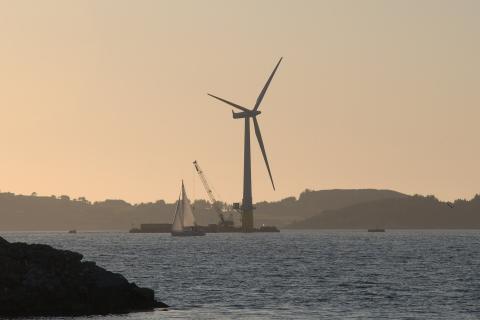France, Norway, UK: Leaders in the Floating Offshore Wind Race
France, Norway, UK: Leaders in the Floating Offshore Wind Race

Countries are advancing technology to harness wind power from greater ocean depths. Offshore wind energy has become a key component of renewable energy production, but has mostly been confined to shallow waters, limiting its potential reach. This is set to change with the advent of floating wind technology.
Floating wind technology involves mounting a turbine on a buoyant substructure, anchored to the seabed with chains. This allows deployment in waters 300 meters deep or more, unlike traditional seabed-mounted turbines, which become uneconomical beyond 60 meters. This advancement is expected to expand wind energy to new markets, including the Mediterranean, with hopes of full commercial viability by the decade’s end.
Key Players in Floating Wind
Europe: Despite losing its title as the world’s largest offshore wind market to the US and China in 2022, Europe still leads in floating wind, accounting for 79% of new additions last year. The region boasts 208 megawatts of capacity, or 88% of global installations, primarily from small demo projects. Countries are now gearing up to scale production to commercial levels.
- France: On track to develop the world’s first commercial floating wind farm, the Pennavel project off the coast of Brittany is expected to produce 250 megawatts, powering 450,000 people annually by 2031.
- UK: Aiming for 5 gigawatts of production by 2030, the UK is progressing with government-backed projects.
- Norway, Ireland, and Mediterranean countries are also showing significant interest and development.
Asia: Asian countries are emerging as strong competitors in floating wind.
- Japan: Announced four candidate areas for demo projects in October 2023. The Marubeni Offshore Wind Development Corporation is planning a demo project with two turbines in 400-meter-deep waters.
- South Korea: Developing one of the largest floating wind farms, slated for completion in 2028, and investing in manufacturing and ports.
Floating wind technology not only promises green, local energy production but also the revitalization of coastal communities. Projects like France’s Pennavel pledge to use local resources, creating jobs and investing in regional economic development. Floating wind projects, which require substantial port infrastructure, can drive investments and upgrades in ports, fostering local growth.
Government Support is Crucial
For floating wind technology to succeed, robust support from governments is essential. The UK is seen as a strong contender due to its clear ambitions and support for projects, attracting investors. Governments need to address economic challenges, like inflation, impacting project costs, and provide certainty for long-term investments.
Despite current economic headwinds, the floating wind sector is expected to grow rapidly. Realizing the potential of this technology is crucial for meeting global renewable energy goals and providing opportunities for industry and local economies. As Rebecca Williams from the Global Wind Energy Council suggests, seizing this opportunity can help countries build new economic models and actively participate in the energy transition.
Floating offshore wind technology is set to revolutionize renewable energy production by tapping into deeper waters, expanding its reach to new markets, and providing economic and social benefits to coastal communities. With strong government support and continued technological advancements, countries like France, Norway, and the UK are leading the way in this promising field.
Article source: https://www.euronews.com/green/2024/06/30/france-norway-uk-which-countries-are-leading-the-floating-offshore-wind-race
Photo attribution: Lars Christopher, Hywind, CC BY-SA 2.0

Το comment on the article or to read all articles, please sign in or sign up